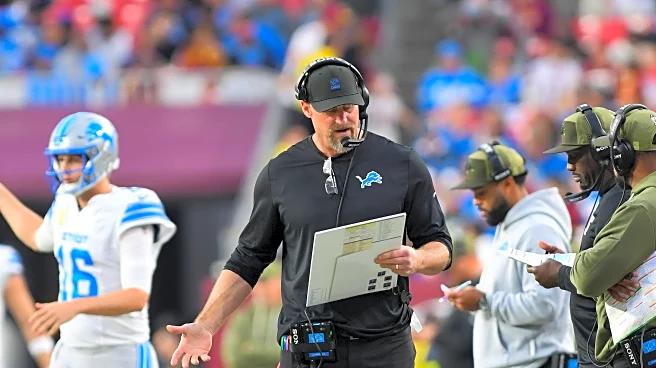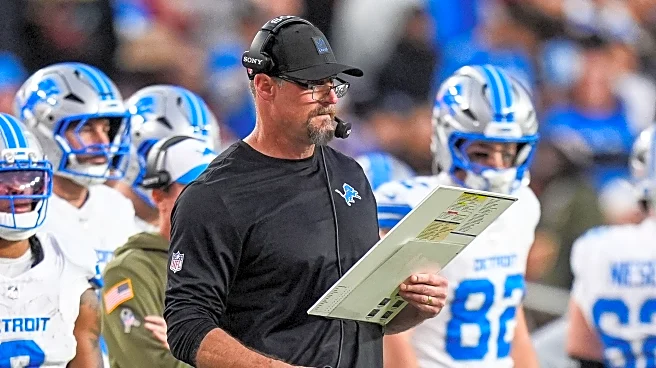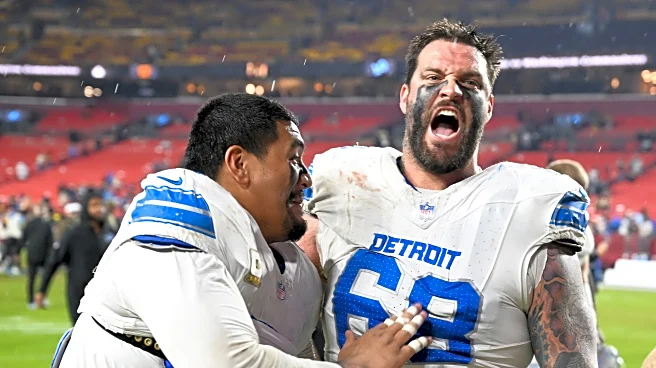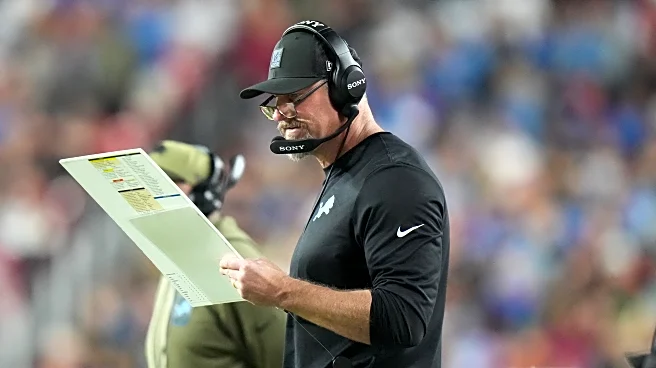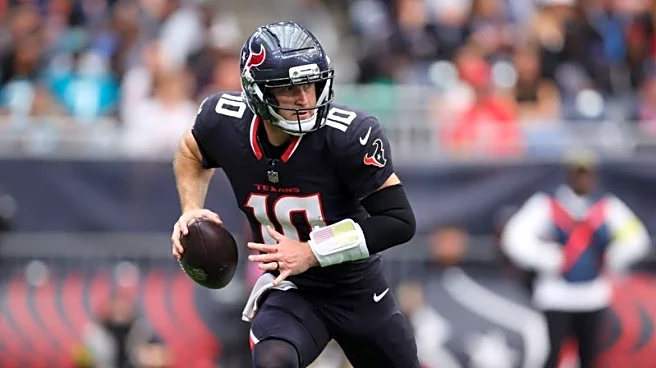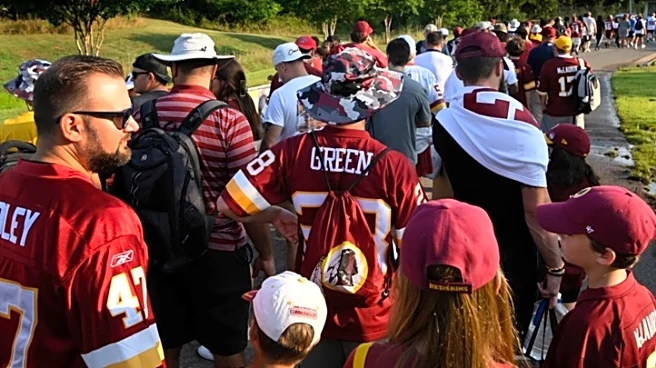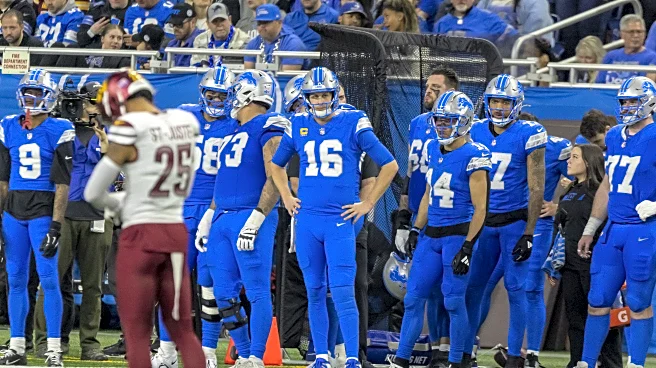Jayden Daniels or not, that felt like a small slice of revenge for last season’s playoff upset — but more importantly, it gave the Detroit Lions and their fan base a much-needed confidence boost as they
found their mojo again, manhandling the Washington Commanders, 44–22.
Dan Campbell looked every bit the dad at the local Applebee’s on a Friday night, grabbing his wife’s reader glasses to scan the draft beer list—and then called a game as masterfully as that same dad executes a perfectly timed “clear the ocean floor” announcement when the food arrives.
With Campbell taking over play-calling, Detroit got back to basics to rediscover its identity. Less zone, more gap-scheme runs. Less shotgun, more under center. Fewer straight dropbacks, more play action. Fewer multiple-tight-end sets, more jumbo looks with extra linemen. Campbell turned every knob in the right direction during the recalibration.
The Commanders aren’t the team they were last year, but this was still a much-needed win—and an impressive one at that. Plenty of stocks deserve to rise accordingly.
Stock up: Jahmyr Gibbs, RB
The Commanders still haven’t found an answer for Jahmyr Gibbs, who picked up right where he left off from their postseason meeting. His performance carried echoes of his multiple-touchdown showcase against the Buccaneers on Monday night earlier this season. While his 172 total yards weren’t quite the 218 he racked up against Todd Bowles’ defense, the quality of this performance might’ve been even better—arguably Gibbs’ most complete game of the season.
Gibbs’ 142 rushing yards marked a season-high and the second-best total of his career, while his 9.5 yards per carry ranked third-best since he was drafted. This was also just the second time in his young career he’s found the end zone more than twice in a game. His 68.4% offensive success rate—the sixth-highest of his career and best of the season—underscored just how consistent and efficient he was. He also posted a 26.7% explosive run rate (four explosive runs, a career high), the fifth-highest mark of his career and another season best.
With his latest outing, Gibbs joined rare company—four Hall of Fame greats, in fact: Barry Sanders, Randy Moss, Emmitt Smith, and Jim Brown—as the only players to score 40+ touchdowns before turning 24. He also joined Sanders as the only players in franchise history to surpass 4,000 scrimmage yards through their first three seasons.
Dan Campbell noted that Gibbs was as upset as anyone after the Vikings loss and played with a chip on his shoulder—and it showed. He ran with purpose and played with edge. Beyond the stat sheet, he delivered an effort block that sprung Kalif Raymond for a little daylight on a screen and also decimated linebacker Jordan Magee on a Texas route for his first touchdown. When he’s rolling like that, there’s no reason not to keep feeding Gibbs—and maybe call one of those Texas routes every week.
Stock up: Jameson Williams, WR
Woodshop substitute teacher Dan Campbell, armed with his spiffy new spectacles, finally found the right measurements to slot Jameson Williams in as a dovetail joint of the offense. The plan was simple and smart—high-percentage throws in defined windows for Jared Goff, getting Williams on the move through crossers and digs over the middle, and letting his acceleration handle the rest. It was precise work—measure twice, cut once—and it paid off. He even continued to flash his growth as a route runner, snapping off a clean deep comeback, while his vertical speed repeatedly stretched coverage and opened space for others.
Williams had just one 14-yard catch in the first half—and that was fine, as the offense poured in 25 points on its first four drives—but he exploded after halftime. On two third-quarter scoring drives, he racked up receptions of 22, 11, 14, 41, and 17 yards, including a touchdown, and finished with a career-high six receiving first downs. His modest 10.0 air yards per target (bottom half of his career games) signaled a shift—Detroit schemed him touches where he could use his speed after the catch rather than just chasing go balls. His 59 yards after the catch were the fourth highest in a game of his career.
It had the Commanders’ secondary in shambles, and it should serve as a blueprint moving forward: get Williams the ball in space and let his rare burst turn structure into chaos—the kind of clean, finished product the Lions have been trying to craft all season.
Stock down: Aidan Hutchinson, DE
Hutchinson wasn’t quite his dominant, consistently disruptive self—and that’s okay. Even with the All-Pro and Defensive Player of the Year expectations hovering, not every game will be a showcase. Some days, he’ll simply look like a borderline Pro Bowler. Still, in a game where the Lions’ pass rush was tepid overall, more of that responsibility naturally falls on their star. Against a Commanders team that entered bottom-10 in both sack rate and pressure rate allowed, the Lions managed just seven total pressures—their second-lowest of the season (only Week 1 vs. Green Bay was lower)—and both sacks came from safety Brian Branch (Roy Lopez also got a half a sack on the second one). That output won’t meet their standard, especially while allowing a Marcus Mariota-led offense to score 22 points. He had a nifty pass deflection, showing great awareness on a tight end screen, but his two QB pressures tied with Week 1 for his lowest since Week 6 of 2023.
Entering the matchup, Commanders rookie right tackle John Conerly Jr. had allowed the second-most pressures (31) and tied for the fourth-most sacks (six) of any lineman in the league, along with four penalties (t-third most). Yet Hutchinson couldn’t capitalize on the mismatch as expected. He also wasn’t a plus run defender for the second straight week. There’s no reason for long-term concern and he’ll expect to bounce back quickly with the Eagles’ tackle tandem of Jordan Mailata and Lane Johnson on deck.
Stock up: Brian Branch, S
Branch’s performance against the Commanders was his most active game of the season and a reminder of why he’s one of the most menacing, versatile middle defenders in football. He played like a pissed off hornets’ nest—flying around with high-velocity and attacking from every angle.
Branch finished with a season-high seven tackles and logged 1.5 sacks, marking the first multi-sack game of his career. It was also the first time all season he was blitzed more than twice (three pass-rush snaps), and it paid off immediately. Since returning from suspension—and ditching the trademark green mouthguard that once plunked to his helmet like a satellite—Branch has looked more disciplined yet just as destructive. Against Washington, he was deployed all around the line of scrimmage as Detroit’s true Swiss Army knife.
While he did get beat once on a 41-yard completion to Jaylin Lane—in extremely tight coverage after rotating post-snap—Branch’s overall impact in coverage was still crucial. He handled a wide range of high-IQ assignments that allowed Thomas Harper to focus on more traditional safety roles, and his flexibility let the Lions keep their base defense on the field nearly all game—with Jack Campbell, Alex Anzalone, and Derrick Barnes each playing every defensive snap.
Stock down: Al-Quadin Muhammad, DE
Muhammad’s outing against the Commanders mirrored his quiet Week 6 performance against the Chiefs. His 21 snaps were his second fewest since Week 1 (only Week 6’s 17 were lower), and his single QB pressure tied those same two games for his lowest total of the season. Outside of Weeks 6 and 10, Muhammad had averaged 34.1 snaps and 4.8 QB pressures per game since Week 2. These two outliers highlight how game flow and situational usage can limit his impact—particularly as the staff continues to show some hesitancy in trusting him on early downs. That hesitancy may now be hindering his ability to find rhythm. Tyler Lacy, who fits better in their preferred five-man base front, out-snapped him by 15 plays.
Beyond his reduced pass-rush impact (just 13 snaps as a rusher), Muhammad’s deficiencies showed up in his limited run reps. The Commanders ran directly at him for some of their longest gains—including two drive blocks from Laremy Tunsil—and he gave up ground against a pull block on a Mariota-designed run. The dip in stock isn’t about effort or ability as much as circumstance: Muhammad’s strengths as a quick, linear rusher are unable to be maximized in game scripts that demand heavier fronts or more early-down sturdiness.
Stock up: Offensive line
A week after landing in this space as the unit most responsible for crippling Detroit’s offensive rhythm, the Lions’ offensive line rebounded in emphatic fashion. This was the lunch-pail, tone-setting group the NFL had grown accustomed to.
All five starters—including Kayode Awosika in his first start of the year—plus Trystan Colon and Dan Skipper, who both filled in capably for a few injury-related series, held firm up front. They controlled the line of scrimmage in the run game and kept Jared Goff’s pocket remarkably clean, allowing the offense to flow freely and reach all levels of the field. Their pass-protection communication and overall chemistry took a significant step forward.
On the ground, Detroit averaged 6.8 yards per carry—a season high—along with a 51.5% rushing success rate (third-highest this season) and 2.27 yards before contact per carry (also third). Every lineman had highlight-worthy moments: Penei Sewell delivered one of his most dominant run-blocking games, Tate Ratledge piled up pancakes, Graham Glasgow anchored the middle with control, and key blocks from Taylor Decker helped spring several of the day’s biggest gains.
Awosika, in particular, deserves a spotlight. He delivered arguably the most complete performance of his nine starts the last four seasons—both as a run blocker and in pass protection—rivaling some of the best left guard showings Detroit has seen since Jonah Jackson’s Pro Bowl peak in Dan Campbell’s first season. He even got nine snaps at right tackle to gain experience at the end of the game.
Quick hits
STOCK UP
- Jared Goff, QB: Goff was back to being Detroit’s precision-engineered aerial assassin. He led the NFL in passer rating for the week (135.9)—his third time doing so this season—while operating like a fine-tuned machine. He averaged 9.7 yards per attempt, completed 75.8% of his passes (+11.5% CPOE), and got the ball out in just 2.67 seconds on average. His +0.71 EPA per dropback ranked as the fifth-best single-game mark by any quarterback this year. This may have been his sharpest all-around effort in distributing the ball, with seven different players recording catches and four topping 49 yards receiving.
- Kalif Raymond, WR: By far Raymond’s best performance of the season—and his best since Week 18 against Minnesota last year. Getting him involved as a credible receiving threat was key, and he delivered: four catches for 49 yards (28 after the catch) and three first downs.
- Sam LaPorta, TE: Steady Sam strikes again. He continues to be an invaluable outlet for Goff and a reliable contributor in the run game. He caught all five of his targets for 53 yards and three first downs, including a clutch third-down conversion early and a huge fourth-down rumble before halftime.
- David Montgomery, RB: It was great to mix him in on the opening drive with Gibbs, give him a fair shake of carries (15), and let him do what he does best—salt away the fourth quarter clock.
- Ross Dwelley, TE: Quietly handled himself well as a run blocker on several of Montgomery’s late-game clock-crunchers.
- Roy Lopez, NT: Ever since the Browns game, when he had a season-high 40 snaps played, Lopez has quietly become one of Detroit’s most efficient interior defenders. He posted a wildly productive stat line against Washington—five tackles, two for loss, and a half sack—all in just 12 snaps. Center Tyler Biadasz and left guard Chris Paul had no answers for his power and leverage.
- Arthur Maulet, NB: A week after being on the wrong side of two tight-window completions against J.J. McCarthy, Maulet rebounded with an effective 16-snap rotation in the slot. While he surrendered one improbable sideline catch to Deebo Samuel, he otherwise matched up well with both Samuel and Zach Ertz, including a key third-down pass breakup on a slant to Samuel.
STOCK DOWN
- Brock Wright, TE: After an uptick in 12- and 13-personnel over the past month, Dan Campbell pivoted toward more jumbo looks, and Wright’s snap count dipped to his lowest since Week 4—his third-lowest of the season (27). When Wright was on the field, the Lions averaged only 4.8 yards per carry and a 45.5% rushing success rate on 11 attempts, compared to 7.9 yards per carry and a 54.5% success rate when he wasn’t. A stark contrast that isn’t flattering for the blocking tight end.
- Alim McNeill, DT: He penetrated into the backfield in a hurry to nearly notch a tackle for loss on the game’s first play and later made a strong stop as the nose tackle on a designed Mariota third-down run, but otherwise failed to make his expected disruptive impact. It was just his third game in the past three seasons without a single QB pressure. McNeill also got moved off the ball more than expected in his matchups with Sam Cosmi. Notably, on the six rushing attempts when McNeill wasn’t on the field, Washington managed just 13 yards (2.2 per rush) and a 16.7% success rate—which would’ve ranked as the best run defensive performance of the week for Detroit.
- DJ Reader, NT: Reader looked a bit more stagnant than usual, getting controlled by both Chris Paul and Tyler Biadasz on several double teams that uprooted him from the line. His 0.0% pass rush win rate on 12 rush snaps underscores the quiet outing. Reader could potentially see a get-right opportunity next week against Eagles backup center Brett Toth.
- Derrick Barnes, LB: Played all 54 snaps but wasn’t an active playmaker around the football in any of the three phases of the game.
- Jake Bates, K: A week after having a field goal blocked for being too low, Bates had an extra point blocked as well. Something clearly needs fixing.
STOCK NEUTRAL
- Tyleik Williams, DT: Logged a season-low eight snaps, and it’s probably time to accept and remember that he was drafted as a long-term investment rather than an immediate difference-maker. His position takes time to master at the NFL level, and for now, he’s earning valuable developmental reps while serving as quality depth on one of the league’s best defenses. Still plenty of season, and career, left before drawing grand conclusions based on the dip in playing time.
- Jack Campbell, LB: Delivered a thrilling front-end collision with Jacory Croskey-Merritt on the failed two-point try and met him a few other times at the line of scrimmage. Overall, Campbell played well—just not quite at the dominant, tone-setting level he’s made the weekly expectation.
- Terrion Arnold, CB: Stacked another superb coverage performance and made a nice goal-line tackle on pop pass to Deebo Samuel, but once again exited early. It’s becoming a troubling trend that’s turning his durability into a legitimate concern.
- Jack Fox, P: Had great seats for the blowout and wasn’t even charged admission. We should all be so lucky to have that kind of day at the office. [Insert: “It Ain’t Much, But It’s Honest Work” meme]
